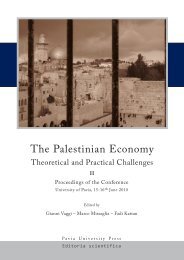Musica che affronta il silenzio - Scritti su Toru Takemitsu - Pavia ...
Musica che affronta il silenzio - Scritti su Toru Takemitsu - Pavia ...
Musica che affronta il silenzio - Scritti su Toru Takemitsu - Pavia ...
Create successful ePaper yourself
Turn your PDF publications into a flip-book with our unique Google optimized e-Paper software.
Music Facing Up to S<strong>il</strong>ence. Writings on Tru Takemit<strong>su</strong><br />
Heard gagaku at the Agency of the Imperial Household. I was really very struck by<br />
the rising sounds that reach up to the sky like trees. If the sound waves of music osc<strong>il</strong>late<br />
in the air, and necessar<strong>il</strong>y exist in time, my impression is that gagaku is a<br />
music which defies mea<strong>su</strong>red time. […] it does not generate an external time but reawakens<br />
a latent internal rhythm […] Listening to the flow of sound it is possible to<br />
conjure up the concept of transience […] In the pauses of a Noh play too there is<br />
something that has to do with eternity. […] I have begun to think about a fundamental<br />
creative approach to the negative space. (Takemit<strong>su</strong> 1995: 6-8)<br />
1961 also saw the first “East-West Music Encounter Conference”, organized by the International<br />
Music Counc<strong>il</strong> of UNESCO and held in Tokyo from 17 to 23 Apr<strong>il</strong>. It drew<br />
many leading international figures: the musicologists Alain Danielou, Mantle Hood, Leo<br />
Schrade, Hans H. Stuckenschmidt and the composers Henry Cowell, Elliott Carter, Lou<br />
Harrison, Luciano Berio and also Iannis Xenakis, who became a great friend of<br />
Takemit<strong>su</strong> – and was very impressed by the antim<strong>il</strong>itarist demonstrations he witnessed.<br />
One of the key questions in a consideration of Takemit<strong>su</strong>’s style revolves around the<br />
role of John Cage in helping Takemit<strong>su</strong> to rediscover his roots. There can be no doubt that<br />
their conversations were fundamental, above all in helping Takemit<strong>su</strong> to conceptualise his<br />
reappropriation of Japanese traditions; at the same time it is a fact that this development<br />
was inevitable and already under way. Before meeting Cage in 1962, Takemit<strong>su</strong> had already<br />
reflected on the special conception of time in gagaku music; he had met Hisao Kanze<br />
and may have discussed the idea of negative time with him, and had also made contact with<br />
<strong>su</strong>ch traditional musicians as the biwa player Kyokush Hirata. 8 In fact Takemit<strong>su</strong> already<br />
had a range of notions concerning ‘music from his own tradition’, and Cage’s words of<br />
wisdom would merely have confirmed him in his orientation.<br />
Here then we have the overall background, with a few deta<strong>il</strong>s which go to make the big<br />
picture more lifelike and also to give a better understanding of Takemit<strong>su</strong>’s composite and<br />
fascinating personality. To quote Mark Slobin: ‘we have learned to think of groups and<br />
nations as volat<strong>il</strong>e, mutable social <strong>su</strong>bstances rather than as fixed units for instant analysis’<br />
(Slobin 1993: X). In the contemporary world the concept of homogeneous cultural<br />
identities has been lost to view, and with it the idea of a head-on clash between groups<br />
representing different cultures. Takemit<strong>su</strong>’s personality shares various ‘multiple identities’<br />
of Japan and the West, making up what Amartya Sen refers to as a single complex entity.<br />
Takemit<strong>su</strong> belongs to a general, if somewhat generic, cultural community of contemporary<br />
music and yet he is perfectly defined by the two expressions ‘Japanese composer’ and<br />
8 On negative time see the chapter on time in Galliano (2002: 12-15); specifically Kunio Komparu, a great<br />
interpreter of noh art, confirms that, ‘Noh is sometimes defined the art of ma’, where ‘the word ma is not<br />
used to indicate something vaguely abstract but to indicate a definite negative time and negative space,<br />
<strong>su</strong>pplying both with dimensions and functions’ (Komparu 1983: 70-72).<br />
121

















